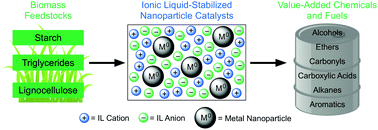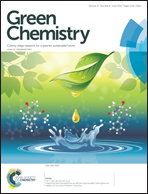Ionic liquid-stabilized nanoparticles as catalysts for the conversion of biomass
Abstract
Biomass resources represent a renewable feedstock of chemicals and fuels to meet the demands of our modern society; however, development of novel catalytic transformations and processes is required to realize a sustainable value chain. Metal nanoparticles stabilized by ionic liquids (NP@ILs) are attractive catalysts for biomass conversions as the overall properties of the catalytic system can be tailored by selecting a suitable combination of the IL and metal nanoparticle components. While the metal nanoparticles define the principle catalytic transformation, the IL provides a stabilization matrix that can tune the surface reactivity of the metal nanoparticles through alteration of the IL cation or anion. Furthermore, the solvation properties of ILs allow the substrate to have direct access to the active sites and effective separation of the product, enabling catalyst recycling or continuous flow operation. Additional functional moieties can also be incorporated into the IL structure, such as Brønsted or Lewis acid sites, to facilitate sequential bond cleavage or formation processes in reaction cascades. The present review outlines the use of colloidal and supported NP@IL catalysts for the catalytic conversion of a variety of biomass substrates, in which the selected examples have been organized into catalyst systems employing non-functionalized and functionalized ILs in order to illustrate the significant potential multifunctional catalysis possesses in the conversion of biomass.

- This article is part of the themed collection: Green solvents for synthesis

 Please wait while we load your content...
Please wait while we load your content...